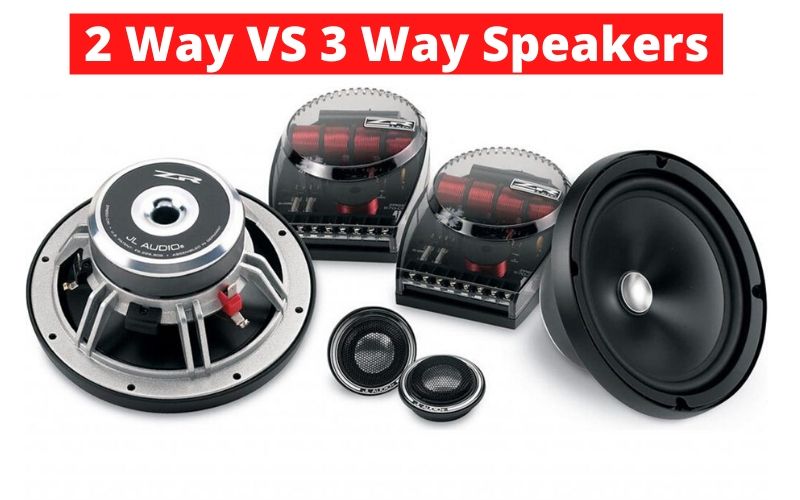If you want to update your car’s sound system, you’ll have to make a few choices about what type of speakers you want. Not all speakers are created equal, so it’s critical to assess the benefits and drawbacks of each component of a car speaker system. Whether you want a 2-way or 3-way automobile speaker system is one of the factors to consider.
What’s the Debate here?
Over the years, there has been much debate, trash talk, and disdain about which type of automobile speaker sounds best: 2-way vs 3-way car speakers?
Music can be your best buddy when you’re driving in your car, whether alone or with your family and friends. you enjoy driving while listening to a variety of music at various volumes. But your question actually is which type of speaker, a 2-way speaker or a 3-way speaker, will benefit your experience the most?
However, if you are a die-hard music fan, you will want to listen to your music at the highest possible audio quality. The speakers you install in your vehicle will have the greatest impact on your audio experience.
Scope around the Globe!
This is a difficult market to understand because there are so many variables to consider. To assist you, we’ve put together this comprehensive guide to assist you in making an informed purchasing decision.
The speaker market has a large selection of sound systems that you can install in your vehicle. Choosing between a 2-way or 3-way automobile speaker system is one of the many options you’ll have to make. But, first and foremost, what does it even mean?
Major Distinction between a 2-Way & a 3-way Car Speaker
For motorists who are familiar with automotive sound systems, the terms 2-way and 3-way car speakers have clear distinctions. However, such concepts are incomprehensible to those who are unfamiliar with sound systems or speakers. If you’re trying to pick between a 2-way and 3-way car speaker, keep in mind that the key difference between the two is the number of drivers.
A 2-Way Car Speaker
A tweeter and a woofer comprise a 2-way speaker.
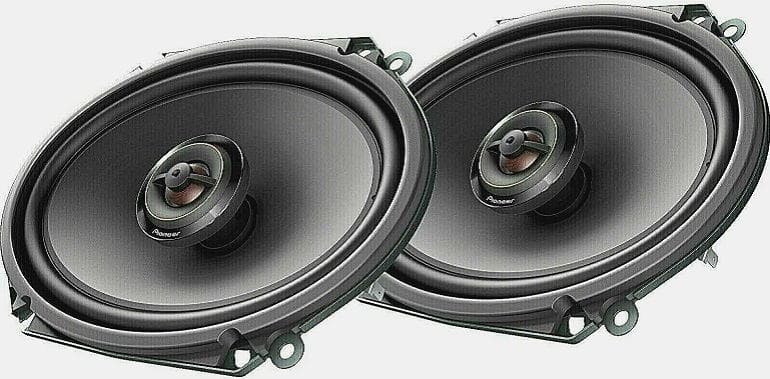
Woofer: Low-frequency sounds, such as those produced by a drum or bass, are handled by the woofer. This means that the woofer in a 2-way speaker is responsible for a portion of the midrange recurrence spectrum.
Tweeter: The smaller tweeter, on the other hand, is responsible for higher sound frequencies such as those produced by a tambourine, a cymbal, or a woodwind instrument.
Crossover: A crossover is also present, which subtracts portions of the incoming sound signal before transferring them to the appropriate driver. 2-way speakers, on the whole, sound better than single-driver speakers.
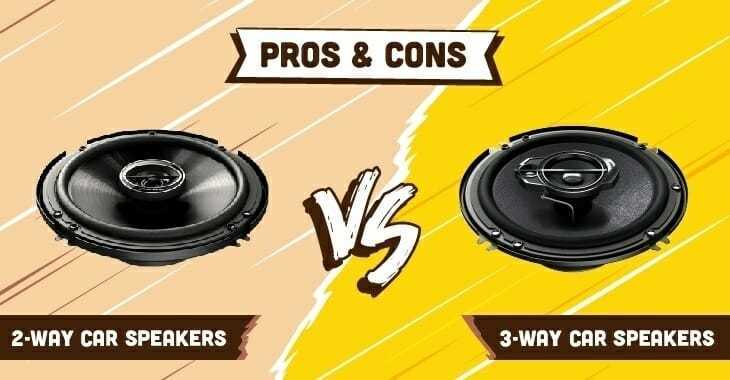
PROS
- 2-way speakers are typically less expensive than 3-way speakers. This is due to the fact that they require less material and a crossover mechanism to split the signal into two sections. However, when high-quality materials or design knowledge are used, these speakers can become quite costly.
- A passive crossover is included with many 2-way automobile sound speakers. This circuit isolates the signal to different degrees but does not enhance it. As a result, 2-way speaker systems can provide improved sound quality while remaining simple to reduce material costs.
- Coaxial speaker frames are perfect for 2-way speakers. These are basically frameworks that have several speakers in the same box. The speakers then produce sound along the same axis.
CONS
- 2-way speakers create a sound that is inferior to 3-way speakers in terms of quality. This is because the mid-range and bass sound propagation have been bundled into the woofer, as opposed to being isolated in 3-way systems.
- The woofer in 3-way speaker systems is capable of handling sound frequencies spanning from 20 Hz to 2,000 Hz, which is a large range that is difficult to cover with a single speaker driver. As a result, 3-way frameworks sift through low and high-frequency noises to produce a woofer sound that gets better over time.
A 3-way Car Speaker
To produce sound effects, a 3-way speaker uses three drivers inside the speaker. Unlike 2-way speakers, the sound stream is divided into three distinct territories in this situation.
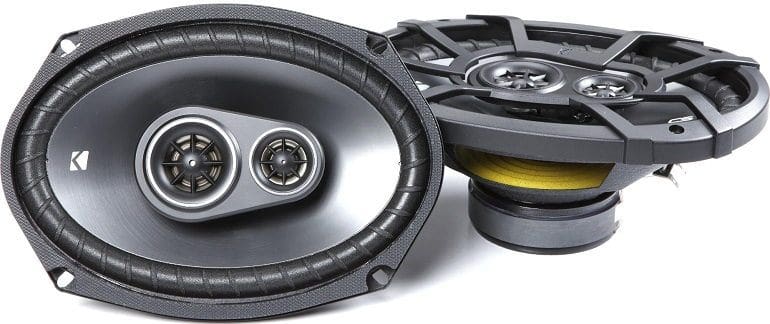
Tweeter: The tweeter is the first range, which handles sounds with a frequency greater than 2,000Hz.
Midrange: The mid-range is the second which is responsible for sounds between 200Hz and 2,000Hz.
Woofer: The woofer is responsible for sounds with a frequency below 200Hz, which is often the base range, in the third and final range. Low, mid, and high are terms used to describe the three areas.

PROS
- 3-way speakers should, on average, deliver higher-quality sound than 2-way speakers. This is especially true when the materials used to construct both speaker frames are the same. 3-way speakers maintain a higher level of purity because the sound signal is split and delivered to drivers that best create the various ranges.
- The construction of coaxial speakers makes distinguishing between 2-way and 3-way speaker frameworks challenging. 3-way speakers, on the other hand, tend to outperform its 2-way counterparts, thanks to isolating drivers that keep tweeters at a higher level near our ears than the mid-range and woofer.
- 3-way speakers create a more prominent and higher-quality bass sound than 2-way speakers. This is due to the fact that the woofer is only dedicated to lower frequencies, whilst the mid-range is responsible for mid-range sound. Bass is an important component of good music because it provides mood and energy to the overall sound quality.
- Another advantage of separating the bass and mid-range in a 3-way system is that it allows the speaker system to take far more power without harm than a two-way system.
CONS
- In both component and coaxial versions, 3-way speakers will often cost more than 2-way speakers. This is due to the upgraded crossover circuit and increased materials used in the third mid-range driver.
- In contrast to 2-way speakers, which can function with low-grade crossovers, 3-way speaker frameworks require a well-assembled crossover. When you consider that the only advantage of 3-way speakers over 2-way speakers is improved sound quality, most music enthusiasts who aren’t audiophiles may not perceive the difference.
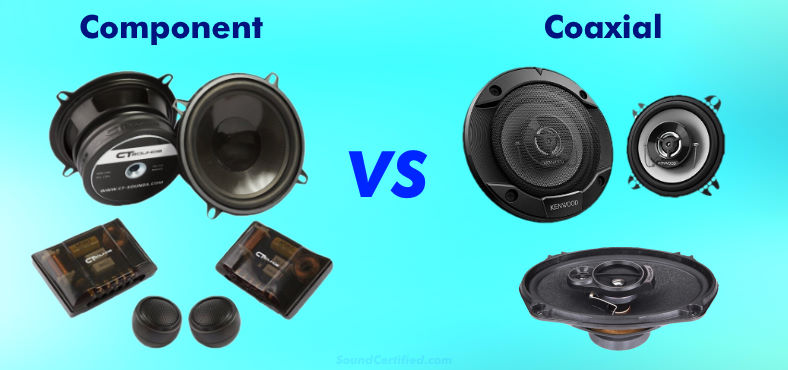
Component Speakers
The term component speaker is self-explanatory. These are two distinct units that work together to create a personalized audio configuration in your vehicle. The larger the speaker, the deeper the bass will be. The more treble frequencies you hear, the smaller it is.
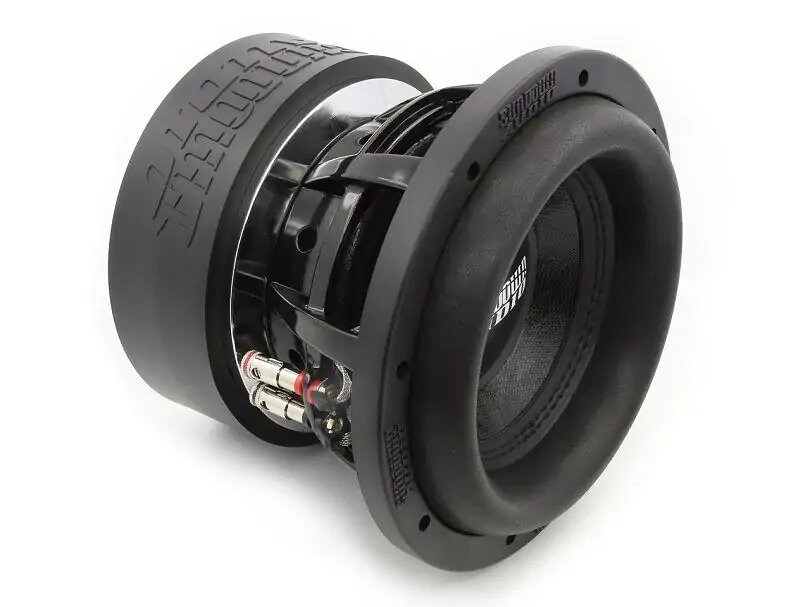
Typically, a component system consists of:
- For bass, an 8”–15” subwoofer with frequencies ranging from 20Hz–200Hz is used.
- A 3.5”–6.6” mid-woofer that gives your music clarity in the 250Hz–2000Hz range.
- The highest frequencies, roughly 2000Hz–20,000Hz, are handled by a 0.5”–1.5” tweeter.
Coaxial Speakers
Simply described, a coaxial speaker combines the woofer and the tweeter into one device. A third midrange driver is included in the three-way variant. The tweeter and midrange speaker are mounted on a rod that runs through the center.

This provides them with the entire range of sound in a small package. Coaxial speakers are the most prevalent type of automotive audio speaker, and they are frequently preinstalled in most new cars.
Concluding Remarks
Now that you understand the differences between two-way and three-way speakers, you must decide which design is superior.
That is a difficult question to answer. The majority of people would choose three-way speakers since our minds are conditioned to believe that more is always better, which is not necessarily true.
2-Way vs 3-Way Car Speakers: Which is Better?
You’ll discover the speakers that best suit your needs. If you’re not sure what you truly want, one option is to remove one of your car’s main speakers. This may assist you in determining what is best for you. If your speaker is old and worn, you might be satisfied with almost any upgrade buy. Choose the one that best meets your demands and delivers the sound quality you want.
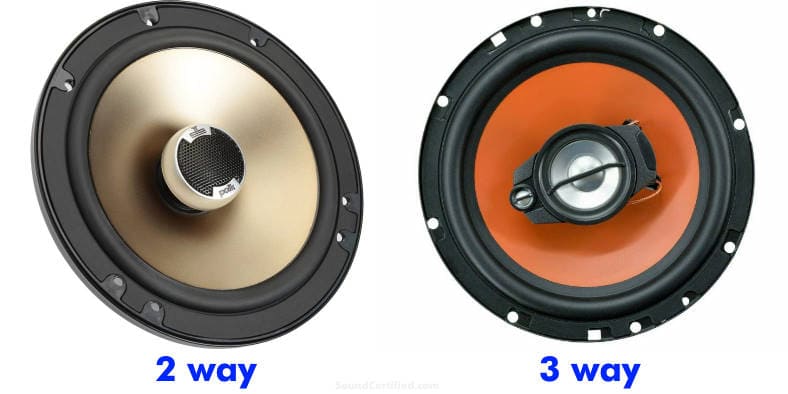
There are numerous alternatives available when you search. For me, I prefer to keep things simple: I buy what I can afford and can install myself since I enjoy the process. Decide what you want to accomplish and when you want to do it, and get started now if you want to.
A speaker system is one of the first things most automobile enthusiasts consider before purchasing a vehicle. This demonstrates the importance placed on the sound quality produced by a car’s audio system, as well as how it affects the car’s worth.
Several aspects will influence your decision between a two-way and a three-way speaker, including your budget and the level of sound quality you expect. At the end of the day, your personal preferences will play a major role in your decision. When it comes to 2-way vs. 3-way car speakers, this article will help you make an informed selection.
Here are some of the best 2-way/3-way car speakers available right now in the market
- RECOIL REM65 Echo Series 6.5-Inch
- Pyle PLG6C 2-Way Custom Component Speaker System
- Timpano TPT-DH2000 Component System
- Rockford Fosgate P152-S Punch Component Speaker
- Crunch CS653 CS Series Component Speakers
- Powerbass 2.75″ Dash Speakers
- Infinity REF-6530CX Reference 2-Way Component System
Check Out more of the Blogs section
- How to Clean a Bluetooth Speaker
- How to Clean the Speaker Grill?
- How Does a Wireless Subwoofer Work?
- How Does Wireless Surround Sound Work?
- Are Component Speakers Better?
- How Long do Speaker Crossovers Last?
Frequently Asked Questions
Do 3-way speakers sound better than 2-way speakers?
Yes, 3-way speakers generally deliver fuller and more accurate sound due to the extra crossover, which enhances midrange frequencies and provides better bass extension.
What are the benefits of a two-way speaker?
Two-way speakers offer clearer and more detailed music reproduction. They often handle more power than one-way speakers because the larger woofer manages bass and midrange frequencies effectively.
What is a 3-way speaker in a car?
A 3-way speaker uses three drivers: mid-range, woofer, and tweeter. Each driver handles specific sound frequencies, producing a more transparent and detailed sound.
What is the difference between 2-way, 3-way, and 4-way car speakers?
A 2-way speaker has a woofer and tweeter, a 3-way speaker adds a mid-range driver, and a 4-way speaker includes an additional “super tweeter” for the highest frequencies, providing a wider range of sound.
Do you need tweeters with 3-way speakers?
Yes, tweeters in 2-way and 3-way speakers handle high-frequency sounds, enhancing overall sound quality.
Do full-range speakers have bass?
Full-range speakers deliver excellent high-frequency response and some bass that mid-range speakers cannot produce, providing a balanced sound.
Can you mix 2-way and 3-way car speakers?
It’s not recommended to mix 2-way and 3-way speakers, as each type is designed to operate within specific frequency ranges.
Do car tweeters make a difference?
Yes, tweeters produce crisp, detailed sounds that add dynamic range, making your music more engaging and complete.
Do 3-way speakers have more bass?
Yes, 3-way speakers offer improved bass response, sound clarity, and a wider soundstage by dedicating drivers to highs, mids, and lows for accurate frequency reproduction.

